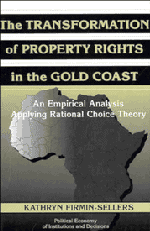 The Transformation of Property Rights in the Gold Coast
The Transformation of Property Rights in the Gold Coast Published online by Cambridge University Press: 08 January 2010
The passage of the Coussey Constitution marked the first in a series of constitutional reforms that would culminate in Gold Coast independence in 1957. With each change, indigenous politicians gained greater responsibility over domestic affairs. By 1954, indigenous politicians exercised most powers of internal self-government; and in 1957, they gained control over matters concerning internal security and external defense. Prior to 1957, however, indigenous actors did not wield coercive authority themselves, and therefore remained dependent on the British to enforce (implicitly or explicitly) their policy decisions.
The changes in the constitutional framework profoundly altered the battle to define property rights in the Gold Coast. Nkrumah used the instruments of central government to redefine property rights. On behalf of his constituency, he claimed for the state land, mineral resources, and even the profits from some individual investments.
The Gold Coast elite resisted the redefinition of property rights and the concomitant redistribution of wealth. In the face of a hostile central government, the elite sought to vest the power to define and enforce property rights in the traditional state. To this end, they launched a campaign to bolster traditional institutions and traditional rulers, placing them at the center of political life; and to redraft the constitution, decentralizing authority so that the central government might not intervene in local affairs.
To save this book to your Kindle, first ensure [email protected] is added to your Approved Personal Document E-mail List under your Personal Document Settings on the Manage Your Content and Devices page of your Amazon account. Then enter the ‘name’ part of your Kindle email address below. Find out more about saving to your Kindle.
Note you can select to save to either the @free.kindle.com or @kindle.com variations. ‘@free.kindle.com’ emails are free but can only be saved to your device when it is connected to wi-fi. ‘@kindle.com’ emails can be delivered even when you are not connected to wi-fi, but note that service fees apply.
Find out more about the Kindle Personal Document Service.
To save content items to your account, please confirm that you agree to abide by our usage policies. If this is the first time you use this feature, you will be asked to authorise Cambridge Core to connect with your account. Find out more about saving content to Dropbox.
To save content items to your account, please confirm that you agree to abide by our usage policies. If this is the first time you use this feature, you will be asked to authorise Cambridge Core to connect with your account. Find out more about saving content to Google Drive.